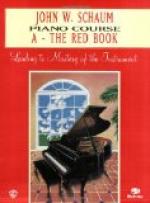In my work as teacher I constantly meet students, and teachers too, who do little or no memorizing. Some do not even approve of it, though it is difficult to conceive how any one in his right mind can disapprove knowing a thing thoroughly. The only way to know it thoroughly is to know it by heart.
CONSTANT REPAIRS NECESSARY
A repertoire once committed must be constantly kept in repair. The public player, in his seasons of study, generally has a regular system of repetition, so that all compositions can be gone over at least once a week. One artist suggests that the week be started with the classics and concluded with modern compositions and concerted numbers. Thus each day will have its allotted task. The pieces are not merely to be played over, but really overhauled, and all weak places treated to a dose of slow, careful practise, using the printed pages. Artists on tour, where consecutive practise is difficult or unattainable, always carry the printed notes of their repertoire with them, and are ceaselessly studying, repairing, polishing their phrases, thinking out their effects.
To those who wish to become pianists, I would say: “Keep your memory active through constant use. Be always learning by heart; do it systematically, a little at a time. So it will be daily progress. So your repertoire is built!”
SECTION V
Rhythm and Tone Color in Piano Playing
How shall two such opposites as rhythm and tone color be connected, even in name, some will ask. One belongs to the mechanical side of piano playing, while the other appertains to the ideal, the poetic, the soulful. The two subjects, however, are not so wide apart as might at first appear; for the beauty and variety of the second depends largely upon the mastery of the first. You must play rhythmically before you can play soulfully; you must first be able to keep time before you can attempt to express color and emotion through any fluctuation of rhythm. One depends on the other, therefore time and rhythm come first; when these are well under control, not before, we can go further and enter the wider field of tonal variety.
Rhythm is one of the pianist’s most important assets, something he cannot do without. It might be said that the possession of a well-developed rhythmic sense is one point in which the artist differs greatly from the amateur. The latter thinks nothing of breaking the rhythm at any time and place that suits his fancy; while the artist is usually conscientious about such matters, because his time sense is more highly developed. A perfect time sense is often inherent in the artist, a part of the natural gift which he has cultivated to such a high state of achievement. It may be he has never had any difficulty with this particular point in piano playing, while the amateur has constantly to struggle with problems of time and rhythm.




